About the Club
In 1974, thirteen Jack Russell enthusiasts met and formed the Jack Russell club of Great Britain.
At that time, with the new law just having been past banning Badger digging, it was felt that many old Jack Russell llines would be lost if some thing wasn't done to try and preserve this wonderful breed.
For some years this club worked hard to educate the general public what a real Jack Russell looked like, for there were many in different areas of the country who called any small white terrier a Jack Russell, just to give it a name, even though it might have shown little resemblance to the real article.
With the formation of this club though, and several of the people who ran it who were dedicated to preserving the old type because of its temperament and unique working characteristics, a standard was established that included one or two very important points. The most important of these being that the Jack Russell terrier should not show any signs of another breed, generally referred to as foreign blood.The more experienced members were normally very evident around the ringside at club shows, to make sure no terriers were allowed to be shown, that “ showed obvious signs of another breed”.
This system of policing the breed ensured that foreign blood could not infiltrate the breed by individuals who, determined to win at shows at any cost, crossed other breeds with their Jack Russell's to produce a superior show specimen. This system worked well until in the late eighties it was evident that several prominent members were in fact crossing their Jack Russell's with “White Lakeland's” and diluted Staffordshire bull blood. This came to a head when, at one National show several terriers were highly placed that were obviously cross bred. Great arguments went on on both sides between the purists, and those who were determined to win at the shows at any cost to the breed.
In 1994 practically all members of the south west region of the Jack Russell club of great Britain met at a special meeting to discus this dilemma, and it was the general opinion of almost everyone present, that if the original undiluted breed was to be preserved, the people of the south and west of England, “the traditional heartland of the breed”, should establish their own club in order to safeguard the remaining pure bloodlines that were left.
Eighty four people immediately joined this club and a committee was formed that same evening. The club was named “The British Jack Russell Terrier Club” with Mr Frank Hall as secretary, and Mr Keath Fleetwood as Chairman. All breeders gave their pedigrees freely to the club so they could be recorded and kept by the club for reference to trace the old bloodlines, and are now on disc, and written in the club's files.
This club is as strong and dedicated today as it was the day it was formed, and is successful for one reason only, and that is its insistence by everyone that no cross breeding be allowed by any one for any reason whatsoever.
Everyone is of the opinion that no other breed that could be introduced into the Jack Russell could improve on it, in fact quite the opposite is the case which has been proven by observing people outside the club who seem to have experimented with every cross imaginable in order to produce a show winner, but have in the process lost the Jack Russell's distinctly friendly temperament, and world renown ability to work successfully below ground using its voice alone, the very reason why Jack Russell created the breed in the first place.
We think this precious gift is worth preserving for future generations, and we put great emphasis on educating new members, especially the young, that what the club is doing in preserving this great breed is vital to the dog world. In its pure form, the real Jack Russell is a very distinct breed of working terrier from all others and very much a part of our English heritage, which our club is committed to preserving.
Committee meetings are open to all club members, although only committee members are allowed to vote. The meetings are always very informal. In fact one wouldn't think one was at a meeting, for they just seem like a gathering of Jack Russell people having a friendly chat, and it works, it has done since the clubs formation. This only works as noone has an advantage in the show ring, because noone is allowed to cross breed, members are therefore confident that they are showing their pure Jack Russells against other pure Jack Russells.
At that time, with the new law just having been past banning Badger digging, it was felt that many old Jack Russell llines would be lost if some thing wasn't done to try and preserve this wonderful breed.
For some years this club worked hard to educate the general public what a real Jack Russell looked like, for there were many in different areas of the country who called any small white terrier a Jack Russell, just to give it a name, even though it might have shown little resemblance to the real article.
With the formation of this club though, and several of the people who ran it who were dedicated to preserving the old type because of its temperament and unique working characteristics, a standard was established that included one or two very important points. The most important of these being that the Jack Russell terrier should not show any signs of another breed, generally referred to as foreign blood.The more experienced members were normally very evident around the ringside at club shows, to make sure no terriers were allowed to be shown, that “ showed obvious signs of another breed”.
This system of policing the breed ensured that foreign blood could not infiltrate the breed by individuals who, determined to win at shows at any cost, crossed other breeds with their Jack Russell's to produce a superior show specimen. This system worked well until in the late eighties it was evident that several prominent members were in fact crossing their Jack Russell's with “White Lakeland's” and diluted Staffordshire bull blood. This came to a head when, at one National show several terriers were highly placed that were obviously cross bred. Great arguments went on on both sides between the purists, and those who were determined to win at the shows at any cost to the breed.
In 1994 practically all members of the south west region of the Jack Russell club of great Britain met at a special meeting to discus this dilemma, and it was the general opinion of almost everyone present, that if the original undiluted breed was to be preserved, the people of the south and west of England, “the traditional heartland of the breed”, should establish their own club in order to safeguard the remaining pure bloodlines that were left.
Eighty four people immediately joined this club and a committee was formed that same evening. The club was named “The British Jack Russell Terrier Club” with Mr Frank Hall as secretary, and Mr Keath Fleetwood as Chairman. All breeders gave their pedigrees freely to the club so they could be recorded and kept by the club for reference to trace the old bloodlines, and are now on disc, and written in the club's files.
This club is as strong and dedicated today as it was the day it was formed, and is successful for one reason only, and that is its insistence by everyone that no cross breeding be allowed by any one for any reason whatsoever.
Everyone is of the opinion that no other breed that could be introduced into the Jack Russell could improve on it, in fact quite the opposite is the case which has been proven by observing people outside the club who seem to have experimented with every cross imaginable in order to produce a show winner, but have in the process lost the Jack Russell's distinctly friendly temperament, and world renown ability to work successfully below ground using its voice alone, the very reason why Jack Russell created the breed in the first place.
We think this precious gift is worth preserving for future generations, and we put great emphasis on educating new members, especially the young, that what the club is doing in preserving this great breed is vital to the dog world. In its pure form, the real Jack Russell is a very distinct breed of working terrier from all others and very much a part of our English heritage, which our club is committed to preserving.
Committee meetings are open to all club members, although only committee members are allowed to vote. The meetings are always very informal. In fact one wouldn't think one was at a meeting, for they just seem like a gathering of Jack Russell people having a friendly chat, and it works, it has done since the clubs formation. This only works as noone has an advantage in the show ring, because noone is allowed to cross breed, members are therefore confident that they are showing their pure Jack Russells against other pure Jack Russells.
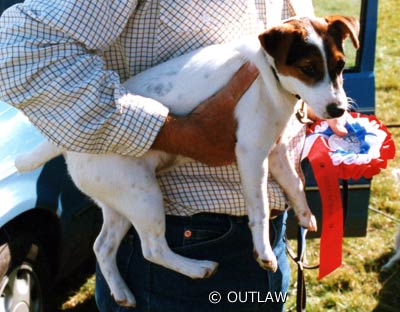
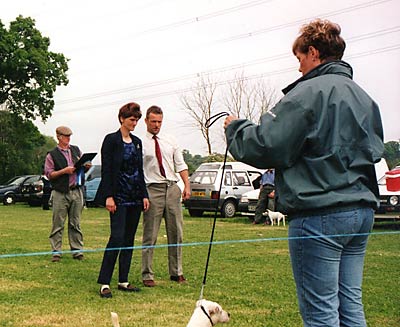
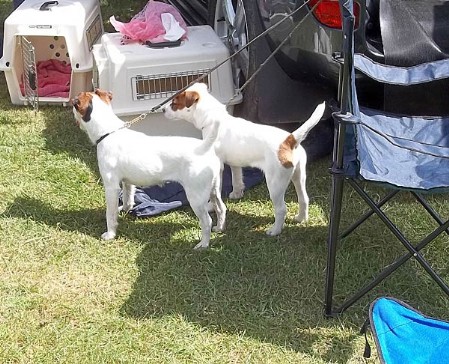
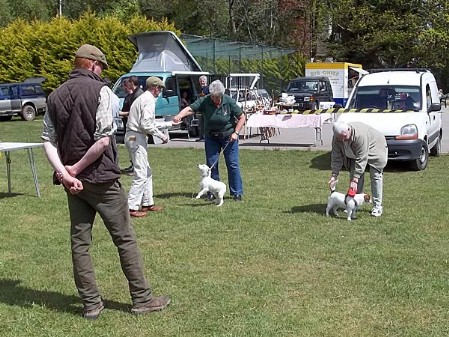
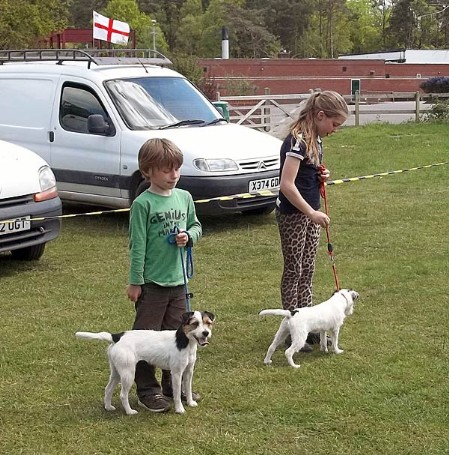
At all club show's, and in a normal year we usually have five, there are always experienced people at ringside, and also an experienced steward selected who make sure no one is allowed to show any terrier that shows obvious signs of another breed. In fact if one is entered, the handler is always politely asked to leave he ring and the reason why explained to them. However, all are welcome to show at our shows, you do not have to be a club member, and there are no restrictions against people from other clubs. If the terrier in our opinion looks pure bred it can be shown by any one.
Recently we have seen an increase in terriers coming from several European countries to our shows, which demonstrates, we think, that more and more people are beginning to recognize the importance of this pure breed.
Our shows are always very friendly and informal, with an old fashioned atmosphere which is quite rare these days. They are a pleasure to attend and club officials are always on hand to give advice to the newcomer.
Our June show particularly, at Julie and Collin Bright's farm at Coombe St Nickolas always has a barbeque and party the night before, where any one can just arrive with a caravan, camper van or tent and join in the fun, one couple spent their honeymoon there last year?
Judges are always picked who have a real knowledge of the breed, and are respected because of it. Then at our Christmas show a club member who has never judged before is always selected to start them on the judging ladder. At this show in particular great emphasis is put on the children of the club, which is always a great success, last years fancy dress class was a riot. The child handler classes get so many entries it has to be split into different age groups.
So having said all that, if you think you are interested to see what a real Jack Russell “should look like” come along to one of our shows, you will be made very welcome, and if you don't like what you see then we are sorry but we don't intend to change our terriers to suit any one, we like them just the way they always have been.
Recently we have seen an increase in terriers coming from several European countries to our shows, which demonstrates, we think, that more and more people are beginning to recognize the importance of this pure breed.
Our shows are always very friendly and informal, with an old fashioned atmosphere which is quite rare these days. They are a pleasure to attend and club officials are always on hand to give advice to the newcomer.
Our June show particularly, at Julie and Collin Bright's farm at Coombe St Nickolas always has a barbeque and party the night before, where any one can just arrive with a caravan, camper van or tent and join in the fun, one couple spent their honeymoon there last year?
Judges are always picked who have a real knowledge of the breed, and are respected because of it. Then at our Christmas show a club member who has never judged before is always selected to start them on the judging ladder. At this show in particular great emphasis is put on the children of the club, which is always a great success, last years fancy dress class was a riot. The child handler classes get so many entries it has to be split into different age groups.
So having said all that, if you think you are interested to see what a real Jack Russell “should look like” come along to one of our shows, you will be made very welcome, and if you don't like what you see then we are sorry but we don't intend to change our terriers to suit any one, we like them just the way they always have been.
Eddie Chapman. Chairman
© BJRTC 2011
